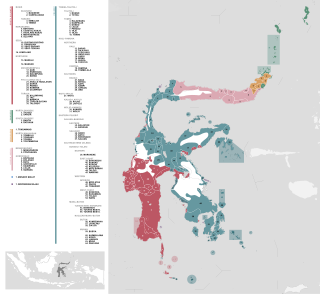Related Research Articles

The Philippine languages or Philippinic are a proposed group by R. David Paul Zorc (1986) and Robert Blust that include all the languages of the Philippines and northern Sulawesi,Indonesia—except Sama–Bajaw and the Molbog language—and form a subfamily of Austronesian languages. Although the Philippines is near the center of Austronesian expansion from Taiwan,there is little linguistic diversity among the approximately 150 Philippine languages,suggesting that earlier diversity has been erased by the spread of the ancestor of the modern Philippine languages.

The fifteen Katuic languages form a branch of the Austroasiatic languages spoken by about 1.5 million people in Southeast Asia. People who speak Katuic languages are called the Katuic peoples. Paul Sidwell is the leading specialist on the Katuic languages. He notes that Austroasiatic/Mon–Khmer languages are lexically more similar to Katuic and Bahnaric the closer they are geographically. He says this geographic similarity is independent of which branch of the family each language belongs to. He also says Katuic and Bahnaric do not have any shared innovations,so they do not form a single branch of the Austroasiatic family,but form separate branches.
Andrew Kenneth Pawley,FRSNZ,FAHA,is Emeritus Professor at the School of Culture,History and Language of the College of Asia and the Pacific at the Australian National University.
Sangir,also known as Sangihé,Sangi,Sangil,or Sangih,is an Austronesian language spoken on the islands linking northern Sulawesi,Indonesia,with Mindanao,Philippines by the Sangir people. It belongs to the Philippine group within the Austronesian language family.
Debuccalization or deoralization is a sound change or alternation in which an oral consonant loses its original place of articulation and moves it to the glottis. The pronunciation of a consonant as is sometimes called aspiration,but in phonetics,aspiration is the burst of air accompanying a stop. The word comes from Latin bucca,meaning "cheek" or "mouth".

Robert A. Blust was an American linguist who worked in several areas,including historical linguistics,lexicography and ethnology. He was Professor of Linguistics at the University of Hawaiʻi at Mānoa. Blust specialized in the Austronesian languages and made major contributions to the field of Austronesian linguistics.

The Temotu languages,named after Temotu Province of the Solomon Islands,are a branch of Oceanic languages proposed in Ross &Næss (2007) to unify the Reefs –Santa Cruz languages with Utupua and Vanikoro,each a group of three related languages.
The Gorontalo–Mongondow languages are a group of Austronesian languages spoken in northern Sulawesi,Indonesia.
The Sangiric languages are a subgroup of the Austronesian languages spoken in North Sulawesi,Indonesia and several small islands to the north which belong to the Philippines. They are classified as a branch of the Philippine subgroup.
The Minahasan languages are a subgroup of the Austronesian languages spoken by the Minahasa people in northern Sulawesi,Indonesia. They belong to the Philippine subgroup.
The Muna–Buton languages are a group of languages spoken on the islands of Muna and Buton off the coast of South East Sulawesi province,Indonesia. They belong to the Celebic subgroup of the Austronesian family.

The Celebic languages are a subgroup of the Austronesian languages spoken on the Indonesian island of Sulawesi,formerly called Celebes. Almost all of the languages spoken in the provinces of Central Sulawesi and Southeast Sulawesi belong to the Celebic group. A few Celebic languages are located in South Sulawesi province. By number of languages,Celebic is the largest subgroup of Austronesian languages on Sulawesi.

On the Indonesian island of Sulawesi,114 native languages are spoken,all of which belong to the Malayo-Polynesian subgroup of the Austronesian language family. With a total number of 17,200,000 inhabitants,Sulawesi displays a high linguistic diversity when compared with the most densely populated Indonesian island Java,which hosts 4–8 languages spoken by 145,100,000 inhabitants.
Mandobo,or Kaeti,is a Papuan language of Mandobo District in Boven Digoel Regency,South Papua,Indonesia.

Coastal Konjo is an Austronesian language of Sulawesi,Indonesia,which belongs to the Makassaric branch of the South Sulawesi subgroup. It is spoken along the coast in the southeastern corner of South Sulawesi in the regencies of Sinjai,Bulukumba and Bantaeng. It is closely related to,but distinct from Highland Konjo,which also belongs to the Makassaric languages.
Tondano is an Austronesian language spoken in the Tondano area of northeast Sulawesi,Indonesia. It is most similar to Tombulu and to Tonsea.
Tonsawang,also known as Tombatu,is an Austronesian language of the northern tip of Sulawesi,Indonesia. It belongs to the Minahasan branch of the Philippine languages.
The Proto-Philippine language is a reconstructed ancestral proto-language of the Philippine languages,a proposed subgroup of the Austronesian languages which includes all languages within the Philippines as well as those within the northern portions of Sulawesi in Indonesia. Proto-Philippine is not directly attested to in any written work,but linguistic reconstruction by the comparative method has found regular similarities among languages that cannot be explained by coincidence or word-borrowing.

Paul James Sidwell is an Australian linguist based in Canberra,Australia who has held research and lecturing positions at the Australian National University. Sidwell,who is also an expert and consultant in forensic linguistics,is most notable for his work on the historical linguistics of the Austroasiatic language family,and has published reconstructions of the Austroasiatic,Bahnaric,Katuic,Palaungic,Khasic,and Nicobaric proto-languages. Sidwell is currently the President of the Southeast Asian Linguistics Society (SEALS) and also regularly organises the International Conference on Austroasiatic Linguistics (ICAAL).
The East Asian languages are a language family proposed by Stanley Starosta in 2001. The proposal has since been adopted by George van Driem and others.
References
- 1 2 "The Team". Bahasakita.com. Archived from the original on 12 March 2020.
- ↑ Michael Clyne (2005). Australia's Language Potential. Sydney: UNSW Press. ISBN 0-86840-727-5. OCLC 64310190. Archived from the original on 1 August 2024. Retrieved 1 August 2024.
- ↑ Sneddon, James N. 1978. Proto-Minahasan: phonology, morphology, and wordlist. Canberra: Pacific Linguistics.
- ↑ Sneddon, James N. (1984). Proto-Sangiric and the Sangiric languages. Canberra: Pacific Linguistics.